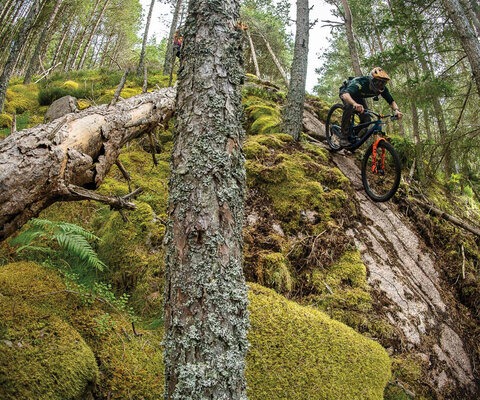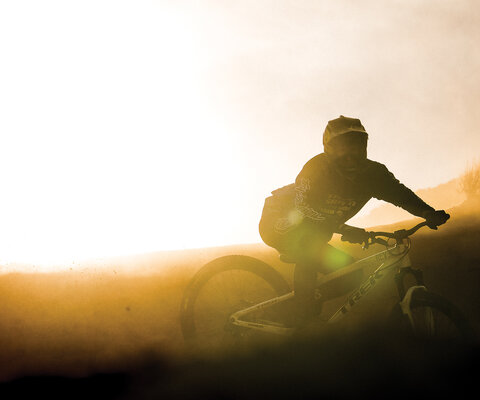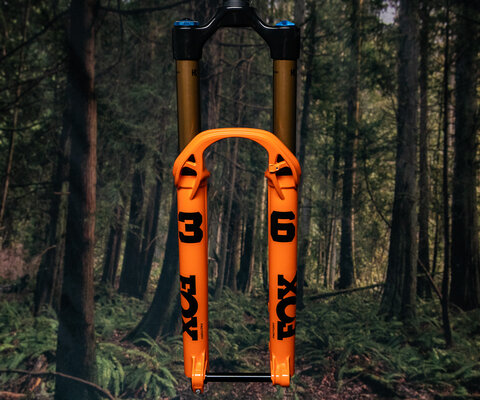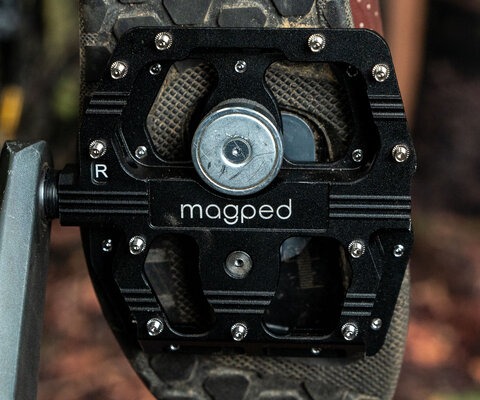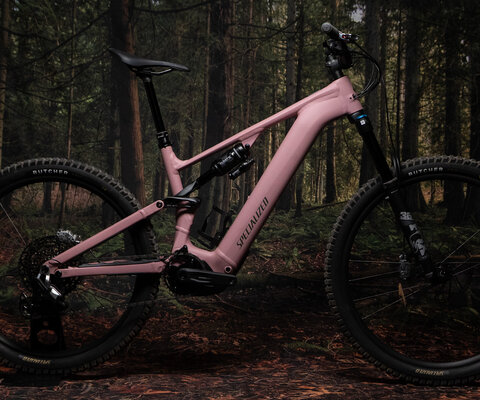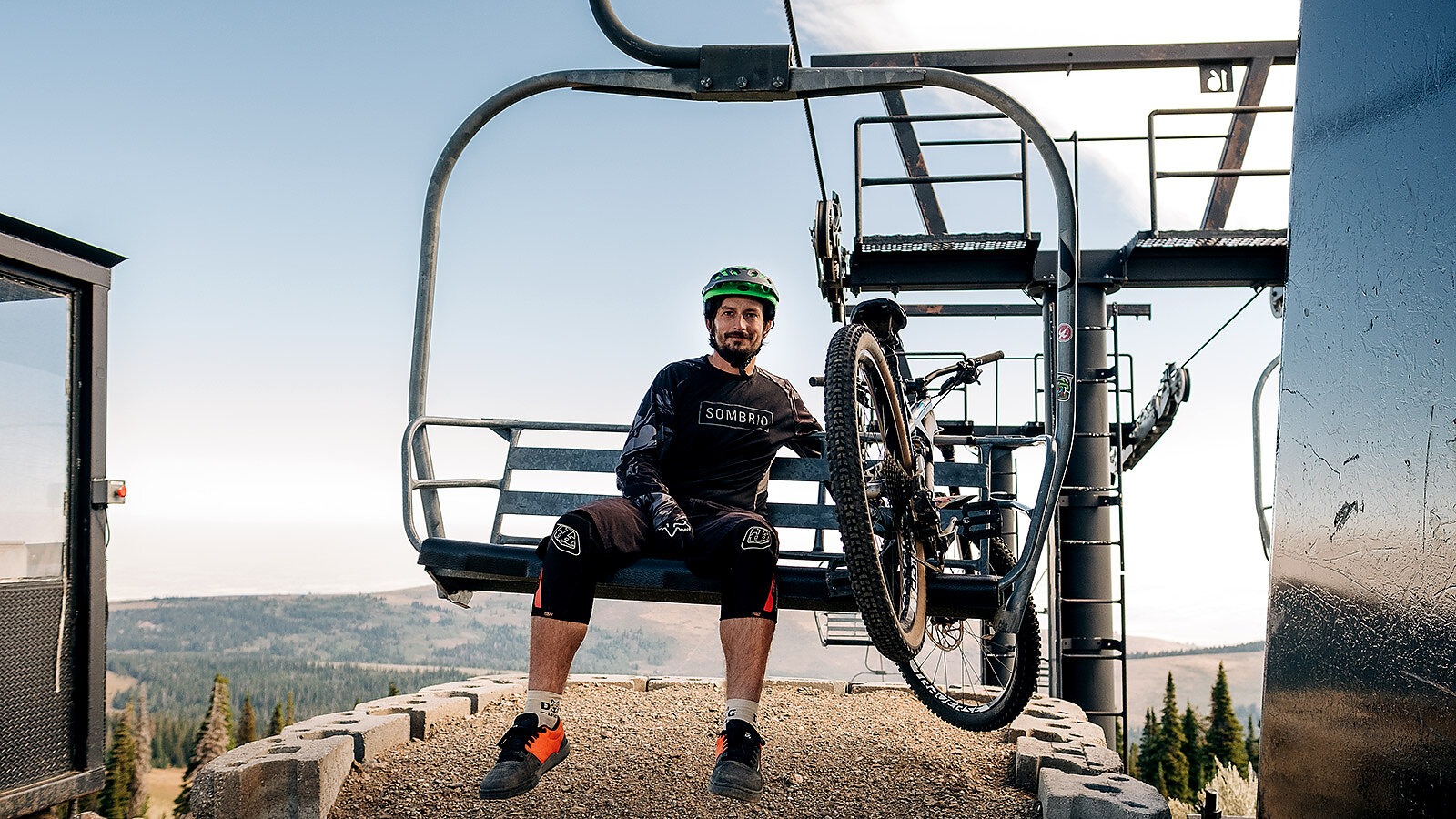
Bucolic Bliss The Pastoral Charm of Pomerelle, Idaho
Words and Photos by Aaron Theisen
“Sorry, we’re kinda slammed today,” the guy handing me my lunch order tells me.
The chairlift at Pomerelle Mountain Resort, in extreme southern Idaho, runs on demand—and today’s traffic of four riders is causing the tickets at the park’s grill to back up as the burger-flipper leaves his post to stop the lift and load bikes. I’ve been watching him run back and forth, slinging bikes over the seat back like it’s the tailgate of a pickup and then ushering riders to climb on alongside them.
Sometimes the chairlift doesn’t run at all if no one from the neighboring communities shows up to this tiny, family-owned ski area that lies three hours from both Boise, Idaho and Salt Lake City, Utah.
I’ve arrived at Pomerelle on a whim, with no expectations. Trailforks shows only one run on the mountain, while the resort website shows none at all. The lift-cum-grill attendant points me toward Pounder.
At the top, I unload my bike and follow his directions into the trees. Kickers constructed from skinned logs launch into low-slung berms as the black-diamond run flows through a forest of Douglas fir.
Halfway down Pounder, a postcard-sized sign nailed to a tree points the way to Chip. I continue through Pounder’s fast, flat turns until they suddenly drop away in a blind four- foot-high huck to flat. Dirt gives way to a dry fall-line creek bed filled with baby head cobble that I can only assume is the trail. It’s one of the rowdiest runs I’ve ever ridden in a bike park, and I wonder who built these trails.
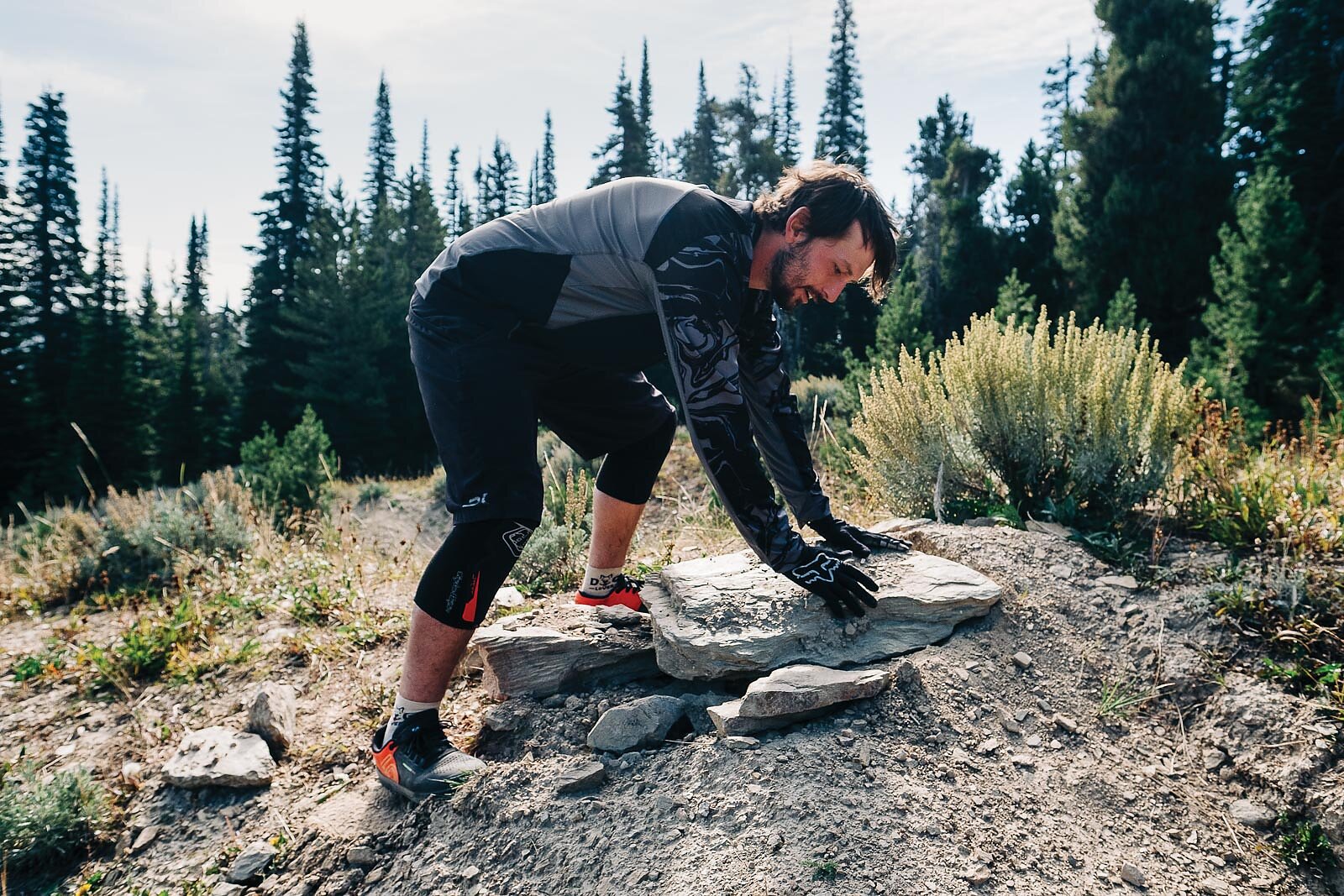
My question is answered during a subse- quent visit, in the summer of 2020, when I return to Pomerelle to ride with Michael Westfall, who is one of the mountain’s principal builders, along with his brother, Nicholas, and Zack Alexander, the resort’s manager. The bike park is closed for the summer due to COVID-19 restrictions, but Westfall has agreed to meet me at the mountain for a day of riding.
“That’s a cow trail,” Westfall says, point- ing to another narrow track. “That’s a cow trail too.”
From the driver’s seat of the bike park’s new Polaris side-by-side, Westfall points out the glut of game trails, half-abandoned paths and bona fide bike trails that stitch across the mountain. It’s a rather loose conglomeration of tracks. In addition to the bovine builders, people from the surrounding communities come and build their own trails; one local retiree comes up nearly every day to maintain a small network of the lower-mountain singletrack by himself.
“Between cows and locals, they’re making all our trails,” Westfall says with a chuckle.
The cows seem to have a natural sense of flow, and it’s one Westfall and his small crew follow—as evidenced by the cow path they’re transforming into a meandering jump line.
Cows are notoriously bad at signage, though. Pomerelle is the only bike park at which I’ve gotten lost repeatedly and left to wonder whether I was on a random game trail or had left the park’s boundaries entirely.
It’s a vast, lonely landscape to get lost in. Pomerelle sits at a base elevation of 8,000 feet on the long, broad shoulder of Mount Harrison, the northernmost peak of the Albion Mountains, a small range surrounded by a sea of sagebrush and century-old farms. To the south, some 10 miles as the crow flies, the City of Rocks National Reserve preserves pioneer inscriptions and wagon ruts from the quarter-million emigrants who passed through this area on the California Trail in pursuit of a new life.
“THAT’S A COW TRAIL. BETWEEN COWS AND LOCALS, THEY’RE MAKING ALL OUR TRAILS.” - Michael Westfall

These days, Pomerelle is not on the way to anything.
In the nearest town, Albion (population: 272), dump trucks tottering with potatoes crawl along the state highway. Here, in Cassia County, cattle outnumber people roughly 10 to one. To the north sprawls the Snake River, the damming of which in 1906 allowed farmers to harness the volcanic soil of the Snake River Plain. That agricultural alchemy earned the area the designation “Magic Valley.”
The dirt is pretty magical up on the mountain too, with soil that would make any trailbuilder salivate—open timber, no underbrush and slope angles just mellow enough to keep the mountain family-friendly for skiing but challenging enough to hold some serious speed on a bike.
Pomerelle began offering lift-assisted mountain biking in the ‘90s, but the Anderson family, which owns the ski area, has been in the ski business for decades. Woody, the family patriarch, began his career at Brighton Resort in Utah before moving on to near-by Alta Ski Area, just outside Salt Lake City. Later, he was instrumental in developing the resort at Park City, Utah, and eventually he purchased Pomerelle with the intention of putting his own stamp on it.
The Anderson family is tight-knit, whether you’re born into it or marry into it. For his part, Westfall married into it, and he lives in a small house with Woody’s granddaughter, Kali, just a stone’s throw from the resort’s lodge. But long before he was officially part of the family, he was already charting his own course on the mountain’s slopes. And, as his friends remind anyone who will listen, that path was initially on a mountain board.
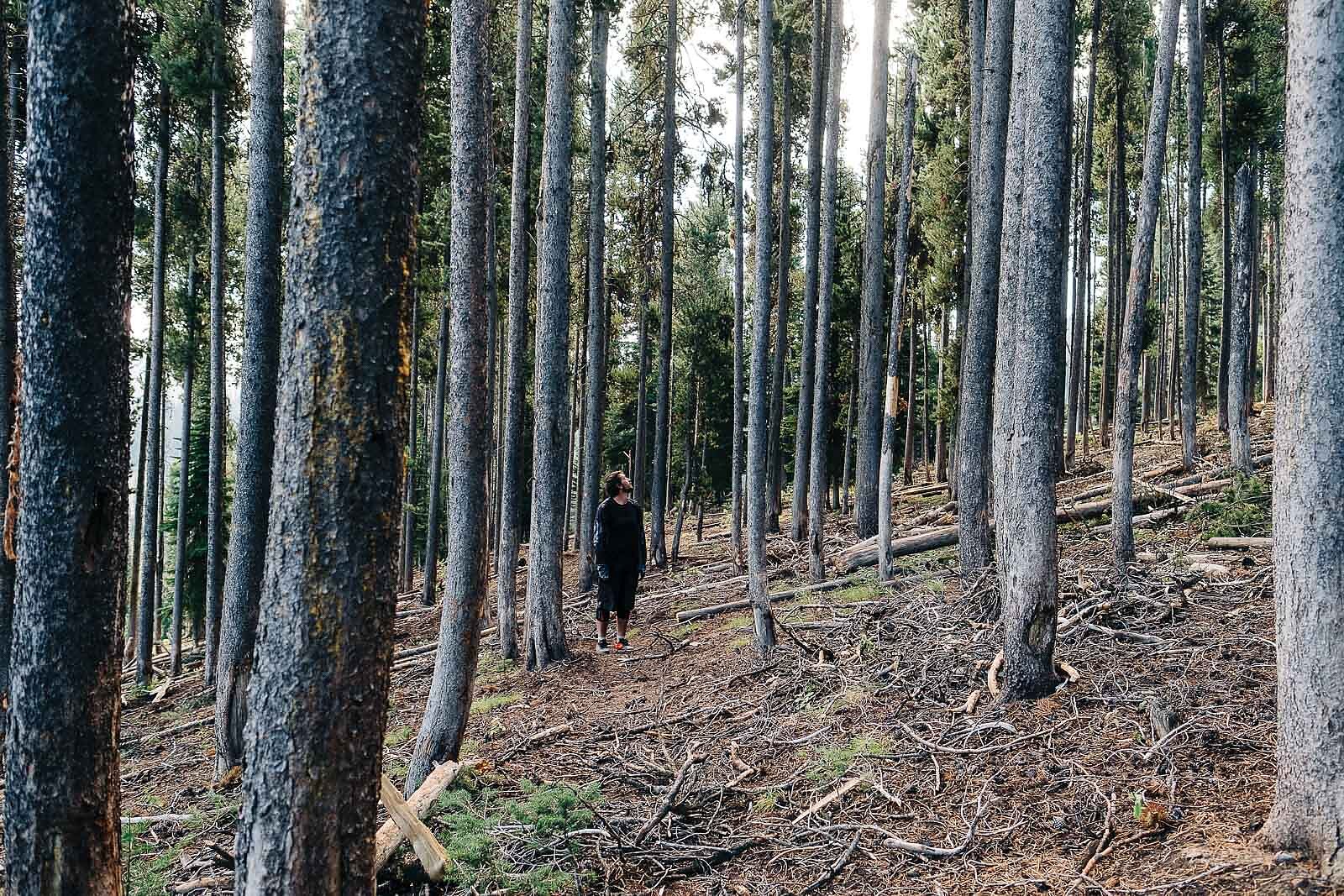
One of his childhood buddies, Erik Henrickson—now a professional mountain biker who lives in Salt Lake City—remembers Westfall gravitating toward these snowboards with wheels after watching a mountain-boarding movie on the Disney Channel. Though his brother and Henrickson had already fallen in love with mountain bikes and would ride them during their frequent summer jaunts to Pomerelle, Westfall persisted trying to master his mountain board on the resort’s dry ski runs.
“Finally, around age 16 or so, he got a mountain bike and was like, ‘I wasted two years of my life on mountain boarding,’” Henrickson says, laughing.
Once Henrickson convinced Westfall that neither he nor anyone else was ever going to be the next mountain-boarding star, they began devoting their efforts to downhill trails, pushing their bikes up the fall line until their calves cramped, building jumps, testing, rebuilding. Inspired by films such as the New World Disorder series, Henrickson and the Westfall brothers simply built what they wanted to ride, regardless of who else might discover them. For both cows and kids, Pomerelle was open range.
"To build easy trails almost seemed like more work,” Henrickson says. “The approach of ‘let’s just pile dirt and build jumps and just kind of skid it in’ seemed a lot easier.”
I see proof of this concept when I ride with Westfall on their in-progress jump trail, Milk. As the track dumps into a sagebrush-flanked ravine, he stops to tweak a flat slab of rock on the deck of a step-up that’s been nicked by a mower: “I think you could hit that and not die now.”
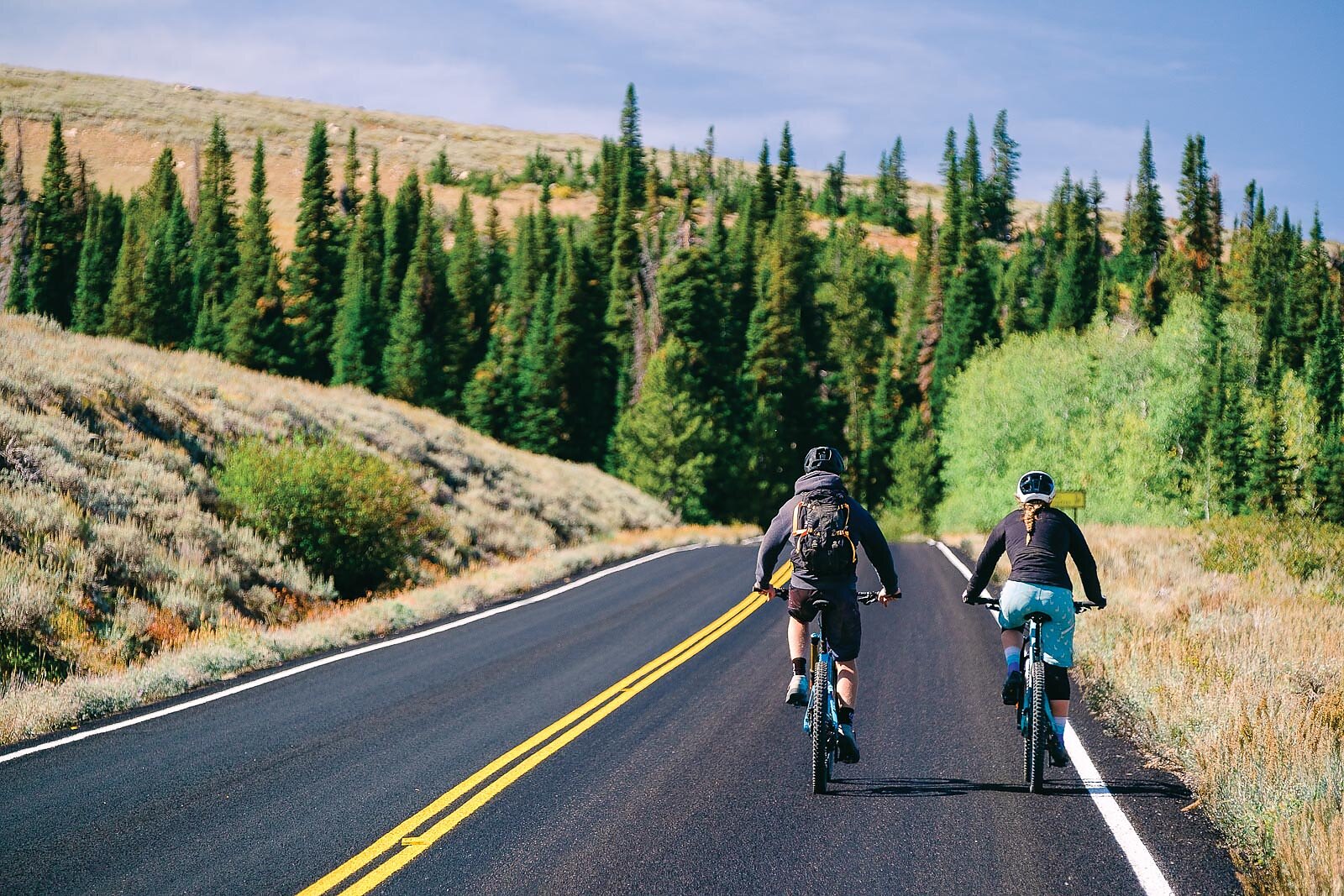
“This jump over here, I just pushed dirt over a log because I didn’t want to cut it,” Westfall adds.
Perhaps this laid-back approach owes something to the fact that digging in the dirt is in the DNA of this agrarian community. Bike season can seem trivial in the face of harvest season, and the stakes are much lower on singletrack than on a seed crop. The attitude extends all the way up: Pomerelle operates on a permit from the Sawtooth National Forest, but the government agency has been remarkably tolerant of the somewhat informal nature of the trail construction process here.
“Pomerelle was pretty chill about it, too,” Henrickson says. “And then Michael married the owner’s granddaughter, which helped quite a bit!”
Henrickson half-jokingly points out another benefit of marrying into the family business: Last year, Westfall was able to purchase the Polaris side-by-side. No longer restricted to shouldering their bikes up the ski slopes, Westfall and the others can put their sweat into swinging a pick. Still, the approach has hardly changed—it’s still a small group of friends building features according to their whims.
The crew still cuts and shapes everything one Pulaski swing at a time, and though Pomerelle has plans to purchase a mini-excavator, for the time being these trails retain a rough-and-rowdy character that reflects the independent spirits of Westfall and his friends. Most of them reveal an intensely personal vision, filled with surprises that prompt Henrickson to describe it as the “Wild West.”
“TO BUILD EASY TRAILS ALMOST SEEMED LIKE MORE WORK. THE APPROACH OF ‘LET’S JUST PILE DIRT AND BUILD JUMPS AND JUST KIND OF SKID IT IN’ SEEMED A LOT EASIER.” - Erik Henrickson
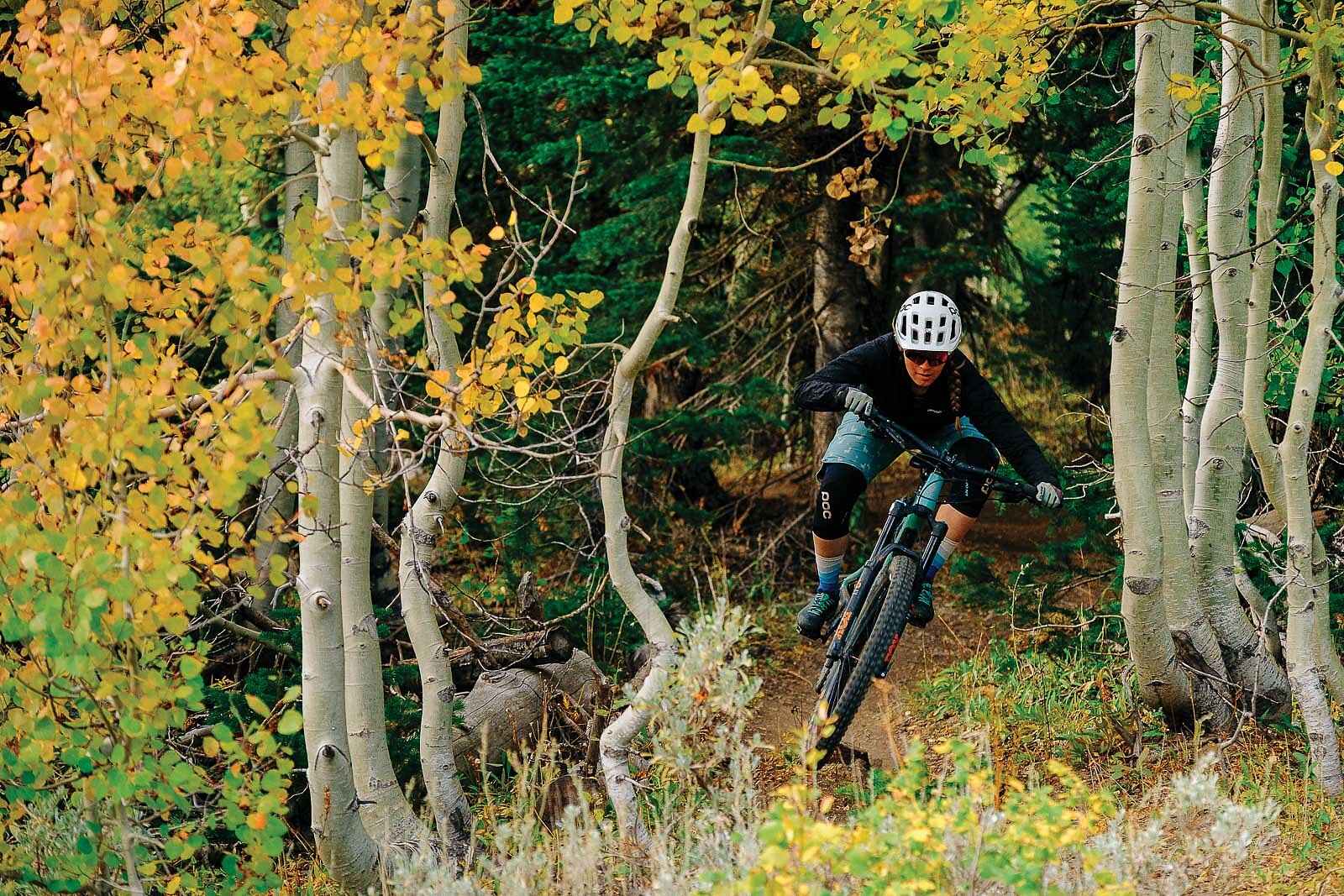
About the time the boys began scratching out singletrack in earnest, the Utah Gravity Series approached Pomerelle while looking for another venue for its race slate. Though the Magic Valley lies within Idaho, it has, arguably, a closer cultural affinity with rural northern Utah than it does with Sun Valley or Boise, and the race series saw promise on the mountain’s technical lines. Once they’d received the series’ specifications, they transformed Pounder—the creekbed double-black I’d stumbled on the previous year—into the pro line for the Pomerelle race. Westfall and Alexander are now working on a new track for the series’ Super D enduro event. They describe it as a fast-and-flowy line that maximizes the cross slopes, rather than plummeting straight down the fall line like Pounder.
It’s unlikely one new trail will change the Wild West character of the bike park, though. Aside from the Pounder race weekend, Pomerelle is essentially empty. That’s great if you’re a local teenager with a yen to build your own backyard trails, but it can be a real headache when it comes to trail maintenance.
“It can be hard to get trails ridden in,” Henrickson says. “Outside of the Pounder, a trail may get ridden by, at most, four people in one day.”
Because the national forest land on which Pomerelle sits is open range, cows can have their way with trails; by August, lovingly constructed berms can turn to cow-trampled moondust. Still, neither Henrickson nor Westfall would trade it for any other trail education.
“Looking back, compared to most places, we had it pretty good up there,” Henrickson says. “We had no problem hitting big features at a ‘real’ bike park, because things here are just as gnarly, but just a little more raw.”
"IT’S MORE ABOUT BEING AFFORDABLE FOR FAMILIES. AND THAT WAS KIND OF DRILLED INTO US BY OUR DAD. IT’S A LEGACY. HIS CALL WAS TO GET PEOPLE OUT IN THE MOUNTAINS." - Gretchen Anderson


Gretchen Anderson, Pomerelle’s marketing director and one of Woody’s children, tells me that, because the mountain serves the nearby agricultural community, its goal is to keep costs reasonable. Lift tickets cost $20 and riders are free to shuttle the paved access road to the top of the mountain rather than paying for a pass. As a result, several generations of the Anderson family work for the resort, flipping burgers and fitting rentals in addition to cutting trails.
“We keep it so incredibly affordable for everyone,” Anderson says. “And we’re always massaging this, because it’s not a huge money-making deal. It’s more about being affordable for families. And that was kind of drilled into us by our dad. It’s a legacy. His call was to get people out in the mountains.”
In 2019, Woody died. The resort, already open only on weekends, closed for the entirety of that season in early August. With the exception of the Pomerelle Pounder weekend, COVID-19 kept the bike park closed during the summer of 2020. Despite being nominally shut down for a season and a half, Westfall and crew have kept themselves busy. There are no design teams or build crews—just a couple of guys building for themselves and the few people who stumble upon the place. The mountain’s winter motto is “What the hell, ski Pomerelle,” and that laissez-faire attitude also clearly applies during summer.
“Dad had a saying, ‘Till death do us part or the season ends,’” Anderson says. Despite Woody’s passing, the extended Anderson family—blood, by marriage and otherwise—continues his mission of getting locals into the mountains. And as long as they keep showing up, the lifts will keep spinning, and the seasons will never end.
![“Brett Rheeder’s front flip off the start drop at Crankworx in 2019 was sure impressive but also a lead up to a first-ever windshield wiper in competition,” said photographer Paris Gore. “Although Emil [Johansson] took the win, Brett was on a roll of a year and took the overall FMB World Championship win. I just remember at the time some of these tricks were still so new to competition—it was mind-blowing to witness.” Photo: Paris Gore | 2019](https://freehub.com/sites/freehub/files/styles/grid_teaser/public/articles/Decades_in_the_Making_Opener.jpg)
